Since its inception in 2018, the Azerbaijani-Italian GaRKAP project, (CAMNES Florence, University of Catania, Baku Academy of Sciences, OELLE Foundation), co-funded by the Ministry of Foreign Affairs and International Cooperation and co-directed by Nicola Laneri and Bakhtiyar Jalilov, has had as its primary objective the deepening of knowledge of ancient societies that were located in the territory of WesternAzerbaijan between the 4th and 1st millennia BC.C.
After an initial analysis of burial contexts, since 2021 the archaeological mission has focused its efforts on the investigation of a settlement, Tava Tepe, located in Ağstafa province, a few kilometers from the Kura River valley, inhabited from the Late Bronze to Iron Age (ca. 1500-730 BCE).
During the first years of excavation, housing structures with mixed earthen and timber architecture emerged, characterized by decorative terracotta elements with geometric patterns, stylized human figures, scrolls and spirals as the main decorative patterns. Stone objects related to agricultural activity were also found.
In the last two years of excavation, along an outcrop on the southern slope of the site, a circular structure with concentric earthen walls, about 15 meters in diameter, was unearthed. The earliest phase is characterized by a complex earthen building with a circular plan bordering a floor where numerous bowls and cooking vessels were found, around a pseudo-circular oven with eight semi-circular installations with traces of burning on one side. On the other side, a thick layer of ash was found with about ten clay tokens inside - some of them with hemispherical loaf-like shapes - and fragments of animal bones. Not far away, a smaller oven was located in the southeastern part of the chamber.
Also visible on the floor are post holes, probably used to support a reed and straw roofing system, traces of which can be recognized on the outside. The outer circle may have been used for meal consumption or animal slaughter, given the high percentage of cattle and sheep bone remains found in the fill layer. The entrance to the circle, located to the east, must have been clearly visible from the Kura River and consisted of large wooden posts placed along the door jambs.
The building uncovered at Tava Tepe appears to have been a meeting place for sharing meals among communities passing through the region about 3500 years ago, confirmed by the fact that at the end of use the structure was sealed and the deposit of pottery in the later phase indicated a memorial attendance of the original circle.



 |
| In Tava Tepe, Azerbaijan, discovered circular structure, probably an ancient kitchen |
Warning: the translation into English of the original Italian article was created using automatic tools. We undertake to review all articles, but we do not guarantee the total absence of inaccuracies in the translation due to the program. You can find the original by clicking on the ITA button. If you find any mistake,please contact us.